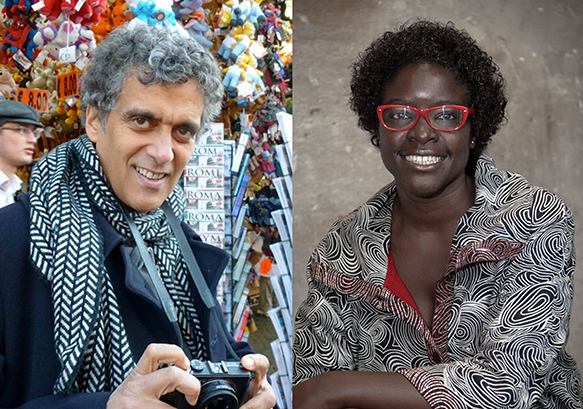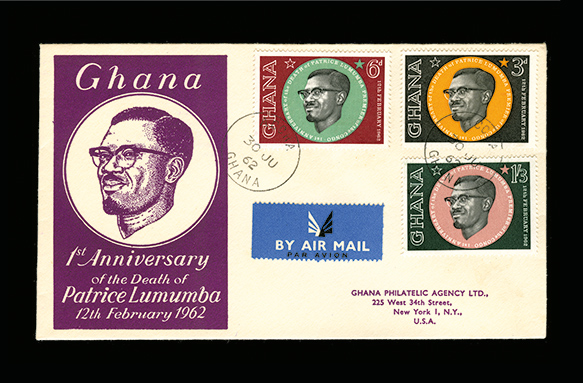10th Caderno Sesc_Videobrasil takes on connections between art and history
On February 5, 2015 (Thursday), at 8pm, Associação Cultural Videobrasil and Edições Sesc São Paulo are launching the tenth issue of Caderno Sesc_Videobrasil at Livraria da Vila (São Paulo, Brazil). At the event, Elvira Dyangani Ose, the first foreign curator ever invited to conceive a Caderno issue, will discuss the Uses of Memory with the artist Theo Eshetu, a video art pioneer. The meeting will be open to the public and hosted by Teté Martinho, the editorial coordinator for Associação Cultural Videobrasil.
The Spanish-Guinean, London-based Elvira Dyangani Ose is the curator of the upcoming edition of the Göteborg International Biennial for Contemporary Art (2015), in Sweden, and former international curator at London’s Tate Modern (2011-2014). For Caderno Sesc_Videobrasil 10: Uses of Memory, she has compiled seven essays and artistic propositions by some of the foremost artists and researchers from African and diaspora countries, who have contributed with texts, interviews, photographs, video stills, illustrations and digitized documents. Their collaborations address the scenario of massive decolonization in Africa between the decades of 1950 and 1970, pondering on archives and history as the focus of art and on the latter’s connection with the building or retrieval of memory to reformulate historical representations.
“Many contemporary artists defy the claim of history’s truthfulness or completeness, and claim art as an exercise in memory construction and/or retrieval that aims to reformulate historical representation,” Dyangani Ose relates. To all of the guest collaborators on this publication, “art provides them with an alibi to claim from an individual perspective the narration of a collective memory,” the editor writes in the introductory text that lends its title to Caderno, Uses of Memory. [Learn more about Elvira Dyangani Ose and her edition of Caderno 10]
At the publication’s launch, Dyangani Ose will speak with Theo Eshetu (UK/Ethiopia), artist who lives and works in Berlin and had his work shown at the 54th Venice Biennale, at Tate Britain (London, UK), at the Stedelijk Museum (Amsterdam, the Netherlands) and at the New Mueseum (New York, USA), among others. Eshetu’s contribution to Caderno is an artistic proposition of a fragmented account, based on video footage from his trip to Ethiopia to pay tribute to his grandfather, a former member of the court of Emperor Haile Selassie (1892-1975).

Archive, memory and history: artistic practices question hegemonic narratives
Eshetu’s contribution to Caderno Sesc_Videobrasil 10: Uses of Memory falls in line with those from other artists and researchers who produce or reflect on art practices that involve archives, memory and history in attempts to broaden, problematize or assign new meanings to hegemonic narratives.
Another highlight is a contribution from the The Otolith Group, a duo composed of Anjalika Sagar and Kodwo Eshun, nominated for the 2010 Turner Prize, Britain’s premier visual arts prize. Exploring the legacies and potentialities of liberation struggles, tricontinentalism, future scenarios and science fiction, The Otolith Group has exhibited at the dOCUMENTA (13) (Kassel, Germany), the 29th Biennial of São Paulo (Brazil), Tate Britain and Tate Modern (both in London, United Kingdom,) and the Stedelijk Museum (Amsterdam, Holland). In Narcissus in Uniform, the group examines postage stamps issued in Africa in the 1960s, claiming said stamps “overlooked the unstable land of Africa’s newly independent states.” The comprehensive research work culminated with the Statecraft (2014) installation, shown recently at the Bergen Kunsthall (Norway), which portrayed the decolonization process as a political calendar created using postage stamps. The Otolith Group featured in the 15th Festival (2005) with Otolith, a video work which is part of the Videobrasil Collection.

frame from "In the Year of the Quiet Sun", 2013 © The Otolith Group
Also on Caderno, the artist Maryam Jafri presents the visual essays Getty vs. Ghana, Corbis vs. Mozambique and Getty vs. Kenya vs. Corbis, all from 2012, which contrast identical historical photographs found in these countries’ official archives with those found in the image banks of commercial photo agencies. The piece “digs into some of the high-powered Western image bank databases, denouncing their inattentive compilation of data and manipulation of photographs, but most importantly, highlighting the disputes around ownership, between public institutions and private corporations,” Elvira writes.
Nice Time, by the artist and researcher Emma Wolukau-Wanambwa, is also about a photo collection: she focuses on rare copies of a series of photographs of prisons in the Uganda Protectorate, produced by the British government in the 1950s. The archives had been smuggled in from the colonies, then on the verge of independence, into the United Kingdom, to ensure that following their independence, the former colonies had no access to information that might embarrass the government or constitute grounds to legal claims. In this proposition, says Elvira, “the persisting tension in the narrative of colonizer-colonized” becomes apparent.
Chimurenga is a pan-African collective self-denominated as “an object that changes from project to project: an occasional print magazine, a workspace and a platform for editorial activities.” Current projects include the quarterly journal Chronic; the Chimurenga Library, eventual project and research facility and online archive for editorial endeavors; and the Pan African Space Station, an online music platform. Chimurenga collaborates to Caderno 10 with FESTAC ’77 – A Research Project, a mapping of the legacy of the 2nd World Black and African Festival of Arts and Culture, held in Lagos, Nigeria’s biggest city, in 1977.
Two reflective essays expand upon the issues outlined by the editor and by the artistic collaborations featured in Caderno 10. In Archiving to Oblivion, Yaiza Hernández Velázquez, a professor in Exhibition Studies, Philosophy and Art Theory at Central Saint Martins (London, United Kingdom), explores the reasons why archives became “a concern of contemporary art” throughout the 1990s. “Perhaps this is best understood not as a genre, a medium, a theme, or a precondition, but as an attempt to escape the ahistorical place to which it had traditionally been assigned,” she writes. “Archiving is not what it used to be, neither is memory or, for that matter, the museum. The archives of fore stood as carefully guarded buildings, linked to the administration of power. (…) Today, they have been largely replaced by an ever-expanding mass of unprocessable data.”
In A different direction: writing history with the craft of a work of art, the critic, curator, editor and researcher Tracy Murinik, who specializes in contemporary art production from the African continent, interviews Premesh Lalu, a history professor and the director of the Centre for Humanities Research at the University of Western Cape in South Africa, about the intersections between art and history in the country and in Africa as a whole. “I think that what many artists are doing is actually showing how difficult the connection is between history and art. The discipline of art history is a discipline that struggles on the African continent, because it struggles to hold these two configurations in any degree of semblance and coherence. It is so troubling that I think we have the potential and the possibility here in shifting direction; in asking a different question about the relationship between history and art,” Lalu suggests.
The pan-African character of this issue and the internationality of the collaborations and guest participants expand upon topics addressed in recent Caderno Sesc_Videobrasil issues: Caderno 9 (Geographies in Motion), curated by Marie Ange Bordas, explored territorialization and emotional cartographies, while Caderno 8 (Belong), curated by Moacir dos Anjos, re-signified and inquired into notions of belonging, tackling the stalemate between the dilution of borders of national identity and the affirmation of regional cultural specificities. These are fundamental subjects to Associação Cultural Videobrasil, which is especially dedicated to fostering, spreading and mapping contemporary art from the Southern geopolitical scene, working for art and culture in areas that require novel forms of circulating and giving visibility to their productions.
Caderno Sesc_Videobrasil 10: Uses of Memory features editing by Elvira Dyangani Ose, editorial coordination by Teté Martinho and graphic design by Daniel Trench + Celso Longo. The bilingual (Portuguese/English) 144-page publication will be available at Livraria da Vila – Fradique and Sesc’s online store from the date of launch for R$ 56.00.
DETAILS
Caderno Sesc_Videobrasil: Usos da memória [Uses of Memory]
A production of Serviço Social do Comércio and Associação Cultural Videobrasil
Curated by Elvira Dyangani Ose
São Paulo: Edições Sesc São Paulo, n.10, 2014. Annual. 144 p.: ill. with photographs
Bilingual (English/Portuguese)
ISBN: 978-85-7995-166-4
Caderno Sesc_Videobrasil 10_ Uses of Memory
Editorial
Solange Farkas; Teté Martinho
Uses of Memory
Elvira Dyangani Ose
Archiving to Oblivion
Yaiza Hernández Velázquez
FESTAC ’77 A Research Project
Chimurenga
Blood. Of light and likeness
Theo Eshetu
Getty vs Ghana / Corbis vs Mozambique / Getty vs Kenya vs Corbis
Maryam Jafri
Narcissus in Uniform
The Otolith Group
Nice Time
Emma Wolukau-Wanambwa
A different direction: writing history with the craft of a work of art
Premesh Lalu interviewed by Tracy Murinik
INFORMATION
Launch of Caderno Sesc_Videobrasil 10: Uses of Memory, featuring a conversation between curator/editor Elvira Dyangani Ose and artist Theo Eshetu, hosted by Associação Cultural Videobrasil editorial coordinator Teté Martinho
WHEN: February 5 (Thursday), 8 pm
WHERE: Livraria da Vila bookstore – Fradique store | Rua Fradique Coutinho, 893 – Vila Madalena, São Paulo
Free admission




